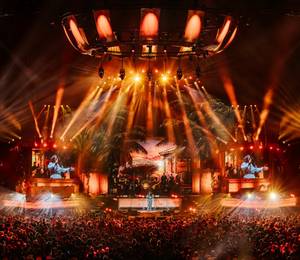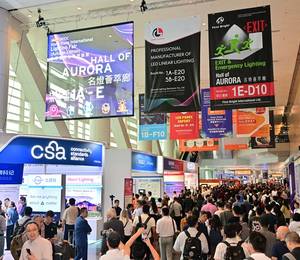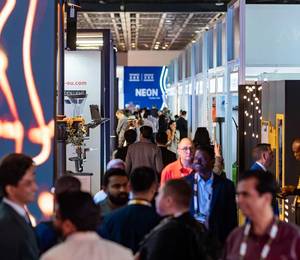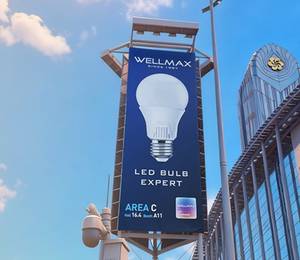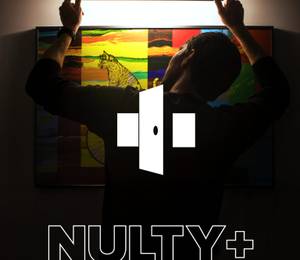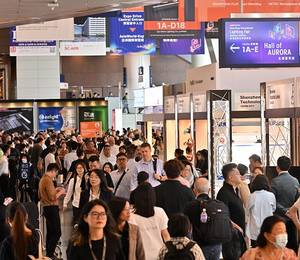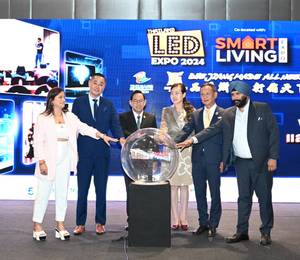Guangzhou, China – The 29th edition of Guangzhou International Lighting Exhibition (GILE) and 21st edition of Guangzhou Electrical Building Technology (GEBT) will be held concurrently from 9 – 12 June 2024 in areas A and B at the China Import and Export Fair Complex.
The shows will expand to occupy over 230,000 square metres and cover 23 exhibition halls. Human-centric spatial design and city planning will become a core focus to deeply connect people with art, technology and business. Innovations in interior design and advances in LED technology will provide exciting opportunities for the industry.
Under the concept of “Light – The Power of Infinity”, GILE 2024 will continue to provide participants a platform for broadening their horizons and gaining inspiration, developing new techniques, technologies and applications with the quality of light and digitalisation in mind.
As the world moves from traditional manufacturing to a new era where advances in technology, reliance on the internet and new lifestyle trends all play a major role in the economy, the lighting industry has emerged as one of the leading adopters of innovation. In the future, the use of light will be more efficient and the full-spectrum of light will be widely applied. Meanwhile, driven by China’s dual carbon policy, product design and manufacturing are moving towards low energy consumption. Virtual reality technology will also be applied to large-scale light shows, while smart lighting and home appliances will have more applications, with luminaires becoming integrated with household furniture and decorations. Human-centric lighting will therefore become an important trend of the lighting industry’s future development.
On the industry’s development and the fair’s theme, Ms Lucia Wong, General Manager of Messe Frankfurt (HK) Ltd said: “Stepping into the age of ‘data technology’, AIoT technology has made significant breakthroughs, becoming more streamlined, sophisticated and wide ranging in its applications. New consumption patterns are shaping lifestyle trends while personal health and environmental impacts are also affecting individual purchasing decisions and behaviour. The lighting industry is developing from standalone LED products to an interconnected system, from display stores to immersive experience stores, and from traditional sales to a unified marketing strategy integrating all sales channels. There are infinite possibilities for the lighting industry right now, so that’s why the show is building on the previous theme of ‘Light +’, with the concept of ‘Infinity’ to encourage industry players to bring about improved spatial experience, better quality of life and a zero-carbon future.”
The Power of Infinity: Evolution of Light +
In the era of “Light +”, the lighting industry will develop to encompass more and more new applications. “Infinity” therefore aptly represents the future roadmap of the industry, helping to inject cities with lighting that improves people’s living and working conditions and provides entertainment for residents and tourists alike.
The infinite applications of light include AIoT, optical communication, big data, healthcare, cosmetics, lifestyle, low carbon and new energy solutions, aquaculture, new media arts, extended reality and much more. To better represent the wide range of new applications for lighting, the show will present eight concepts, each corresponding to a letter in the word “Infinity”:
I: Intelligent solutions for new challenges
The lighting industry has long been at the forefront of the research and design of smart technology, especially in AIoT. Looking forward, smart lighting is poised to evolve further through making use of self-learning algorithms based on individual user habits. These advances in technology add additional value to products, turning them from simple light fixtures into smart products that manage and regulate our environments.
N: Net-zero future
In response to the “dual carbon” goals of carbon peak and carbon neutrality by 2030 and 2060 respectively outlined by the Chinese government, sustainable lighting presents more value to the industry. In recent years, alongside the rapid development of LED technology, minimising energy consumption and emissions has become one of the key objectives of the industry. LEDs, smart technology and new energy have together contributed to achieving these goals across a variety of fields.
Highly efficient lighting products that make use of both green and smart technology are set to become predominant. These can then be applied towards many applications including the arts, tourism, cities, buildings, roads, car parks and other areas. The combination of advanced energy storage solutions with net-zero carbon smart lighting systems will increase the adoption of renewable energy in cities. Building streetlamps that also function as EV charging piles to cater for roadside charging has potential to further this trend.
Smart lighting technology also has a role in agriculture and horticulture, helping to improve crop quality and yields, and the efficient use of resources such as water can reduce energy consumption. This leads to lower emissions and water consumption.
F: Five senses experience
By integrating sound, light, shadow, AI, VR, new visual media and haptic technology with the tourism industry, immersive experiences for tourists can be created using all of the five senses. This represents a significant upgrade to lighting technology serving the tourism industry.
I: Individualism and customisation
As personalisation continues to permeate all aspects of daily life, people’s physical and emotional needs will become the main focus of indoor lighting. At present, mainless lighting and smart home lighting can adapt to individualised needs and apply to different lighting scenarios.
N: New business models
The “Light +” era has also given rise to new business models, transitioning from the sale of standalone lighting products to delivering a comprehensive lighting service. The twin pillars of this model are design and after-sales service. With a clear service target, the industry needs to design lighting applications using smart and human-centric technology to gain increased customer recognition and demand, and replace existing services in the market.
I: Industry 4.0 leads the intelligent manufacturing future
Industry 4.0 combines the development of automation and informatisation, utilising advanced technologies such as cloud factories, AI, IoT and big data to improve production efficiency. Industrial lighting is evolving to support these integrated systems, incorporating smart and energy saving lighting technologies to ensure safe and healthy working environments in factory settings.
T: Technological innovation
Over the last century, the lighting industry has developed rapidly, evolving from the simplicity of artificial light to the use of advanced technologies including IoT, optical communication and big data analysis and from incandescent bulbs to LEDs and interconnected lighting systems. Throughout this process, industry players have continuously improved the quality of light, aligning their technologies with the needs of the time. Stepping into the era of “Light +”, the role of LEDs has transitioned from a replacement for traditional light sources to an integral role in human-centric lighting, which takes into account people’s physiological and psychological needs. Combining smart technologies with lighting can also improve the interaction between light, spaces, and people, offering increased adaptability to the needs and preferences of individuals.
Y: Yielding infinite possibilities
The future is full of uncertainties, with infinite possibilities and room for imagination. As an industry that is continually on the rise, lighting continues to inspire industry players to strive for innovation despite the ever-changing circumstances.
Ms Lucia Wong continued: “Every industry player strives to improve people’s quality of life. In the ‘Light +’ era, the integration of lighting with other technologies will provide users with more comprehensive targeted services. GILE, together with the industry players, will continue to move towards the infinite possibilities of light.”
The next editions of Guangzhou International Lighting Exhibition and Guangzhou Electrical Building Technology will be held from 9 – 12 June 2024. Both shows are part of Messe Frankfurt’s Light + Building Technology fairs headed by the biennial Light + Building event. The next edition will be held from 3 – 8 March 2024 in Frankfurt, Germany.
For more information regarding the lighting shows in China, please visit http://www.light.messefrankfurt.com.cn or email light@china.messefrankfurt.com
